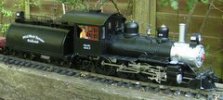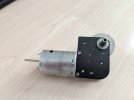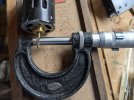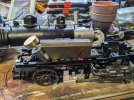Rhinochugger
Retired Oik
By popular demand - OK, one person asked - I will try and put my attempt to improve the Bachmann 4-6-0 in some sort of chronological order with the few photos that I have.
Let's address the elephant in the room:
The Bachmann Anniversary model, which is, I think, the fifth iteration of the 10-wheeler, must be the worst loco that I have ever had the please of trying to take apart. I now remember why I was a bit reticent to undertake this.
There is no logical assembly sequence, super-detailing bits have been added on without any logical thought for disassembly / re-assembly, and it is all too easy, as I found out, to damage bits if you try to dismantle things in the wrong way. For example, the front pair of footboards slide out of / into place once the four screws holding the body to the chassis at this location have been removed. the rear footboards can only be removed from the body, once the body has been successfully disentangled from the chassis and, therefore, have to be fixed back on before the body is offered up to the chassis . That's only one little thing.
. That's only one little thing.
So, why even try?
Well, the Slim Princess is based on an Annie chassis, and has always stuttered from time to time. It'll run OK for one or two laps of the garden, then it will start to stutter. On the other hand, the Centennial 4-4-0 will run smoothly all afternoon. Why does the 4-4-0 run better than the 4-6-0?

Let's address the elephant in the room:
The Bachmann Anniversary model, which is, I think, the fifth iteration of the 10-wheeler, must be the worst loco that I have ever had the please of trying to take apart. I now remember why I was a bit reticent to undertake this.
There is no logical assembly sequence, super-detailing bits have been added on without any logical thought for disassembly / re-assembly, and it is all too easy, as I found out, to damage bits if you try to dismantle things in the wrong way. For example, the front pair of footboards slide out of / into place once the four screws holding the body to the chassis at this location have been removed. the rear footboards can only be removed from the body, once the body has been successfully disentangled from the chassis and, therefore, have to be fixed back on before the body is offered up to the chassis
So, why even try?
Well, the Slim Princess is based on an Annie chassis, and has always stuttered from time to time. It'll run OK for one or two laps of the garden, then it will start to stutter. On the other hand, the Centennial 4-4-0 will run smoothly all afternoon. Why does the 4-4-0 run better than the 4-6-0?





